10 Types of Shower Faucets to Look & Work Great
Author: Omar Alonso | Editor: Omar Alonso
Review & Research: Jen Worst & Chris Miller
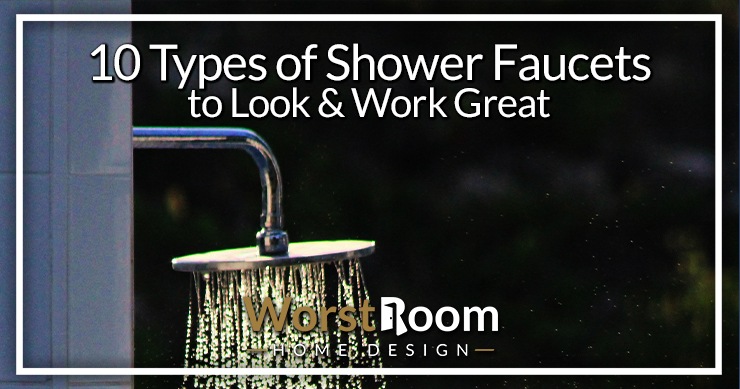
Whether it’s a quick, refreshing wake-me-up in the morning before work or a secret sobbing spot at the end of a horrid day, your shower plays quite an important role in your life. So imagine not having the types of shower faucets that deliver what you need, whether it’s comfort or functionality.
Choosing the right shower faucet will go a long way in ensuring that shower time is more enjoyable and exactly how you want it to be, letting you control a range of factors such as the water temperature, shower controls, and even the aesthetic appeal of your bathroom.
10 Types of Shower Faucets
Luckily, there’s quite an array of faucet choices available for all types of showers; here’s everything you need to know about the different types of shower faucets. Each has their own look, functionality, and sets of pros and cons involved, so please take the time to explore any of them that catch your eye deeply so you make a perfectly informed choice.
Handheld Showers
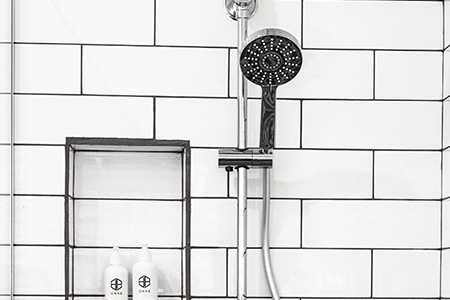
Though handheld showers emerged on the scene quite late, the kind of popularity that these showers enjoy is quite something.
Used across the world, these shower faucets are beloved for the functionality, ease of use, versatility, and flexibility that they afford—you can just as easily bathe yourself as you can someone else, which is super helpful when you have a pet or a child in the family.
Handheld shower faucet types allow better control over the force and temperature of the water, and the flexible tube makes it easier to rinse your body and clean up the bathing area efficiently after a shower.
Handheld showers can be fixed to the wall with a docking station, where the shower sits until it needs to be used. This also increases the functionality of handheld faucets—if you fix the dock at the right height, you can keep the handheld shower in the dock and use it hands-free, like a fixed shower faucet.
Handheld showers come in a range of metals and colors, so if you’re looking for a showerhead to complement your bathroom, you’ll find it quite easily among handheld showers.
However, be aware that given the number of moving parts, the risk of leakage and breakage is higher. The latter case, especially, is quite inconvenient, as one broken part means that the entire setup can’t be used, and if you can’t find the right parts for replacement, you’ll have to replace the entire unit.
Fixed Shower Faucets
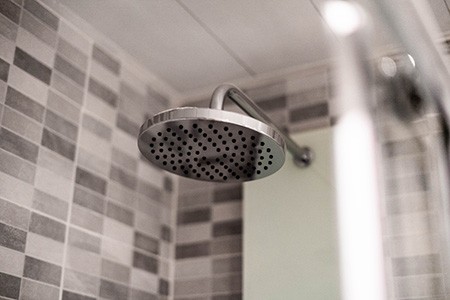
Unlike handheld showers, these faucets are fixed to the ceiling or the wall. The only flexibility that these showers afford is the ability to adjust the water flow’s direction through a partially swiveling shower head.
However, these types of shower faucets are the most commonly used in bathrooms across the country. Water flows through the showerhead through a small pipe that connects the faucet and the water source.
Many folks prefer these types of showerheads for the range of styles and colors and the array of spray patterns built into the faucet (from massaging jets to sprinkles).
Fixed showerheads are also easy to install, last longer with the right installation and maintenance, and are often the cheapest option in the market, so an aesthetic-looking bathroom doesn’t need you to break the bank. Leakage possibilities are also minimal.
However, there’s only so much a fixed showerhead and these shower handle types can do, given its basic design and nature. You can’t easily bathe pets or children and these showerheads don’t come equipped with as many features as other faucets.
Additionally, some people hate the fact that you’ll also have to end up wetting your hair when you use these faucets (ask the long-haired and curly-haired folks about the pain that this is!).
Tub Faucets
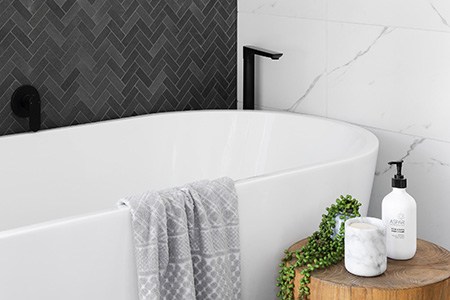
Tub faucets are quite popular since many folks still use the trusted shower-tub combo in their bathrooms, so you have a tub faucet mounted on the wall as well as a showerhead, and you can toggle between the two through a common diverter and handle.
The great thing about these types of shower faucet handles is that on days when you don’t have the time or mood to fill an entire tub, you can simply opt to shower, thanks to the presence of a showerhead. These faucets are also usually sold as a package, so you don’t have to waste time looking for the two parts separately.
Tub faucets are also available in various metals, colors, and styles. The tub faucet can be mounted either on the tub deck or rim (such as Roman tub-filling faucets), on the wall, or on the floor (common in vintage and soaking tubs that are not fixed to the floor). They aren't much different than many outdoor faucet types in look and functionality, minus the temperature control abilities.
Pressure-Balancing Valves
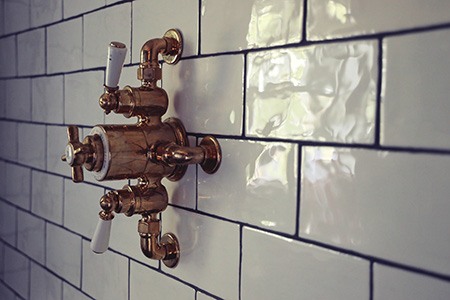
A more modern addition to bathrooms, these valves are capable of controlling water pressure by managing the overall pressure despite changes that may occur in the cold line or the hot line separately.
This is achieved with the help of a spring gasket and a shower cartridge—these little pieces of equipment act as a flow-controlling stopper and as a facilitator for hot and cold water mixing, respectively.
Due to these different types of shower faucets, you can easily control the water temperature. However, the lack of an in-built temperature detector means that even if you set the water to warm to a particular temperature, the showerhead may heat the water over and above it since it can’t recognize the temperature of the water. A thermostatic valve is designed to overcome this problem.
If you live in an old house, a pressure-balancing valve may not be ideal, given that corroding pipes are an all too common problem with these valves and you’ll have to inspect the entire plumbing line for repairs.
Full Shower System
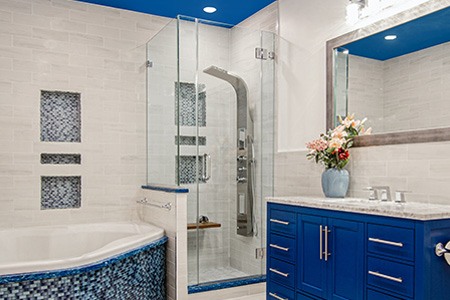
With a full shower system in your bathroom, you have a shower system with the works—a convenient handheld shower, a fixed showerhead, temperature regulation controls, all supporting paraphernalia, and even a tub faucet and overhead shower in higher-end offerings.
Are these shower faucet handle types the best of all worlds? It would seem so! Whether you want to bathe a pet or a child or clean the bathroom or just take a quick shower, you can do all of it with a full shower system.
You can easily switch between the various shower outlets with a diverter valve, and if you want to create a cohesive bathroom look, these shower systems are a great idea.
However, given the many components, extra piping and plumbing may be required, making installation slightly complicated. To avoid a mess, always consult a professional plumber to confirm whether a shower system like this one can be installed in your house.
Overhead Showers
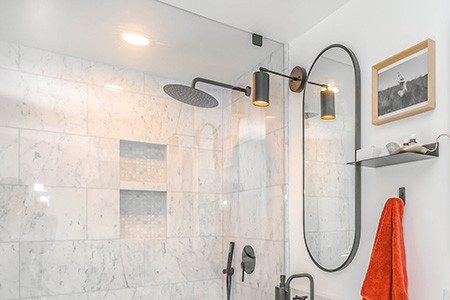
Also known as rainwater showerheads because of the rain-like evenness of the water flow, overhead showers are ceiling fixtures, as opposed to angled, wall-mounted fixtures as fixed shower faucets generally are. You find these often in a zero threshold shower to help keep water inside the desired area.
However, you can still opt for a wall-mounted overhead shower; the angle is eliminated by having a firm pipe extend 90 degrees from the wall, at the end of which the showerhead is attached, so that the flow remains overhead and not angled, despite being wall-mounted.
Additionally, it’s easier to install these different types of shower handles than a ceiling fixture, taking no more than a few minutes for a professional plumber to get the job done. However, you may not get the same coverage and feel as an overhead shower fixed on the ceiling.
If you’re opting for a ceiling fixture, you have a wide variety of configurations and shapes at your disposal, though you’ll require specific plumbing to accommodate this showerhead. These are best installed when the bathroom is being constructed. If you've ever seen a heated outdoor shower you'll understand why.
Thermostatic Shower Valves
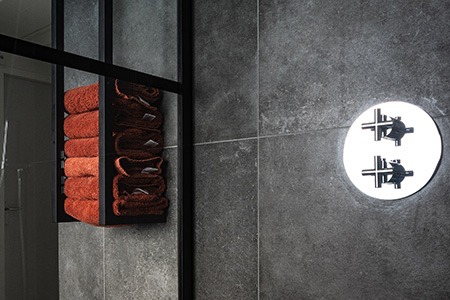
Thermostatic shower valves allow superior temperature regulation, as you can set the temperature of the water before you shower and the valve efficiently mixes cold and hot water to instantly reach your desired temperature.
High-end models of these types of shower faucets even feature anti-scalding technology to prevent fluctuating water temperatures and you can also easily control the flow of water.
With a thermostatic valve, you only need to set the temperature once; the shower system retains this and heats the water to this temperature before every shower.
A diverter valve lets you maintain the temperature while switching between shower outlets. However, thermostatic valves can be quite expensive to buy and install. Installed at the right shower valve height in a "wet room" without a tub surround to step into and these look extremely elegant.
Shower-Only Trim Kits
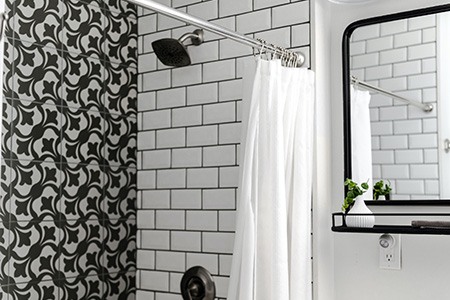
These types of shower fixtures include various valves to control the showerheads and also features a thermostatic valve for water flow and temperature control.
Deluxe Shower Systems
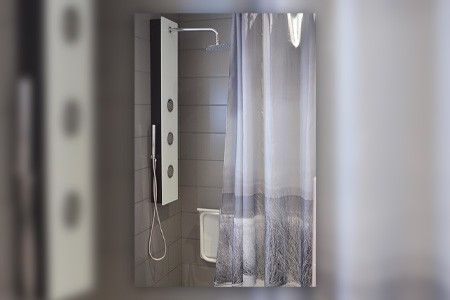
Deluxe shower systems are an upgrade from full showers, featuring the additional option of a body spray (water hitting your body from various angles), installed in the walls surrounding the shower. For a spa-like experience, these shower systems are a great idea.
However, the installation of these types of shower knobs can be quite complicated, with additional piping and plumbing to be professionally installed in advance before you put up a surround, tile, or any shower tile alternatives. The water pressure and water quantity demands of such systems are also quite huge, so you might want to consider that as well before opting for a deluxe shower system.
Single & Double-Handle Shower Faucets
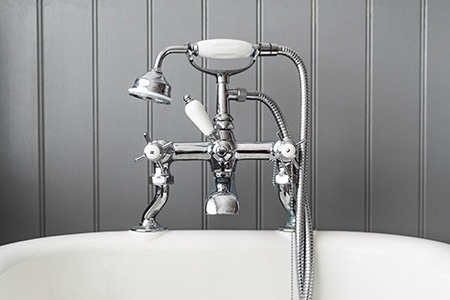
Single-handle shower faucets are basic faucets, letting you control the water flow and temperature only. However, they’re the most commonly sold faucets.
Double-handle shower faucets, on the other hand, come with diverters for temperature and flow control, and are a more traditional variant.
Showers with more than one shower head will feature a transfer valve that can distribute the water flow to multiple faucets. Naturally you'll reduce pressure this way, so you should have a professional measure your pressure to make sure your home can handle this scenario.
Types of Shower Faucets for More Efficiency & Enjoyment
Before opting for a showerhead, take into consideration the plumbing, piping, and water needs—you don’t want to invest in a showerhead only to find out that your infrastructure doesn’t support it.
Having the right choice among these different types of shower faucets can make all the difference to bathing time, no matter what the mood is. Happy showering!



